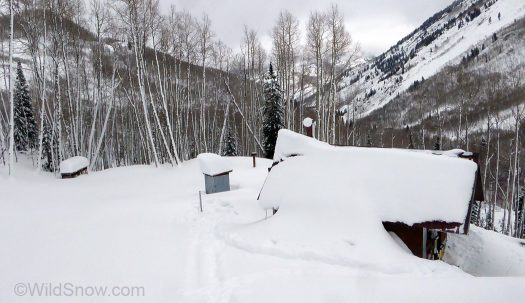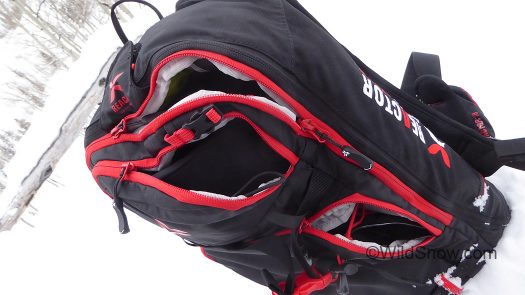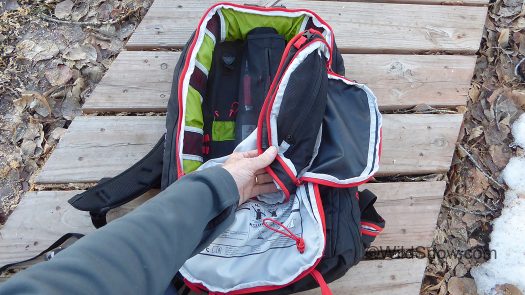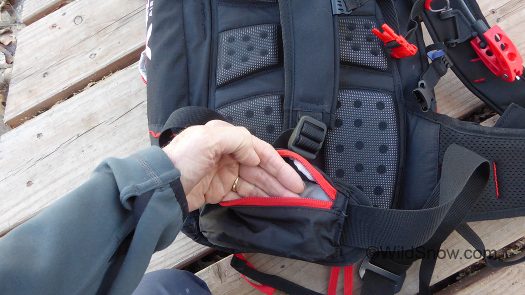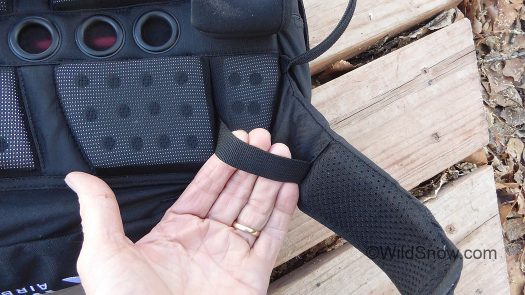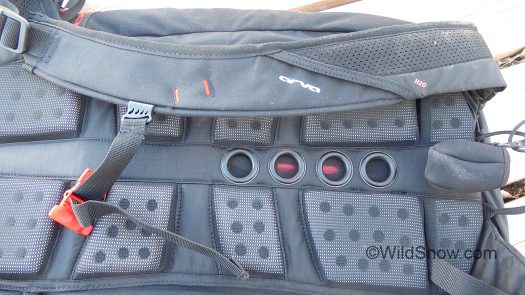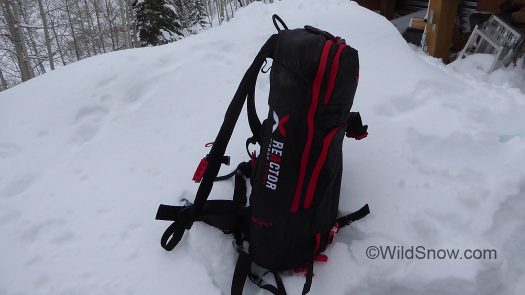
This is an Arva Reactor 18, necessary equipment at WildSnow HQ with 2+ meter of snow on the ground and more coming.
French company Arva comes up with nice gear. Witness, their Reactor 18 L balloon backpack. While a bit heavy at 2672 grams, 5.9 pounds (with sweet little 536 gram argon cylinder), this bag yields a nice compromise of features some shoppers will consider essentials. The “file cabinet” effect may be somewhat excessive, but you organized types out there will like the 4+ zippered layers in the main body, along with an incidentals pouch on the waistbelt.
This is another avy rucksack I found performs with higher cargo volume than the claimed 18 liters, no doubt because of the obviously smaller cylinder, but because the balloon is stored to the sides instead of as a “brain” taking up the top portion of the pack. A bit of added width seems to be there for the side balloon storage, thus overall you get more room.
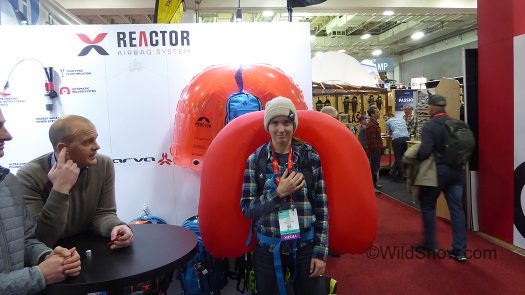
Commodious 150 liter balloon is stored on both sides of the pack. For you technical folks out there, the balloon is divided in half by a baffle that provides some shock damping during impacts, but more importantly maintains 1/2 inflation if the bag is slashed. The Arva guys made a big deal out of this. It seems smart, but I’d rather simply know that the bag was made from super strong fabric (apparently this is).
Arva’s trigger mechanicals are the tried-and-true spring loaded firing pin on a burst disk. Unlike at least one competitor the “gun” must be cocked using a separate threaded tool (remember, if you don’t reset you will waste a filled cylinder as it deploys when you screw it in!).

Torso length anchor inside pack. I thought these were quite clever, especially since they are easy to razor blade out for medium to larger size folks who don’t need them.
Producing various torso lengths in these expensive packs is problematic: ever more specifications for the factory, more SKUs for the retailer. Thus, torso length adjustment can be useful. Arva has one of the more unusual solutions in this regard. The shoulder straps have an auxiliary anchor webbing hidden under the main upper shoulder strap anchor points. You pull this in via an internal cam buckle to do a sort of “faux” shortening of the torso length. Does this work? Probably, to one extent or another. This is a moderatly long-torso pack (21 inch back-panel from upper strap anchors to bottom of waist belt), so a slight shortening of the components probably has the desired effect.
The wide, heavily padded waistbelt is probably overkill for an “18 liter” backpack, but those with bony iliac crests due to 2,000 meters a day may enjoy. Zippered pouch on righthand belt is good, one of my favorite pack features. Waist buckle appears large, but easier to handle with gloved manos.
Leg loop is the simple type that’s anchored to the pack at the waistbelt attachment point, with a loop you thread the waistbelt through. The loop is too small for easy on-off. Fix by using a lightweight locking carabiner such as the classic BD Screwgate. NEVER attach balloon pack leg loop with non-locking ‘biner, too easy for the carabiner to twist and pop off.
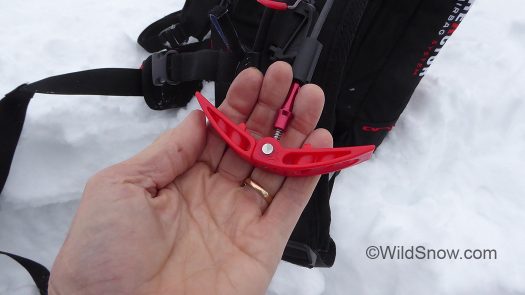
Handle folds out into an easily grabbed shape — that also easily catches on branches and other things. I’m not sure what the best airbag trigger handle is. I like the somewhat cylindrical ones that don’t get caught on things as easily, but these easily grabbed elongated shapes are good too.
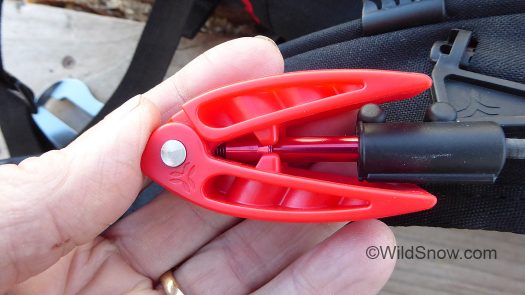
Handle folds, small nibs fold above rim as pictured, to prevent accidental release. It’s possible to fold this and have the nibs end up below the rim, thus not disarming. Easy to correct — but easy to miss.
In stock form left shoulder strap holds the ripcord, which is safetied using by folding the trigger handles and covering with a small neoprene pouch. Problematic, as this is fiddly and you can easily mess up by not folding the handles so they engage a small lock above the actuation cable end. if you mess that up, catching something on the handle, even while folded, can still trigger the airbag. Trigger can be swapped left or right, though only the has high-low positions. Strap without threaded trigger cable is available for hydration tube or radio mic cord.
This is a front panel loader. Lower compression strap heads all the way around, but the upper has to terminate before running over the vertical packed balloon on the sides of the pack. Indeed, some problematic stuff going on here when it comes to diagonal ski carry (and A-frame certainly not in the picture). A lighter pair of planks will probably hang fine, but gigantic skis might sag backwards unacceptably unless you cinch them in by anchoring to the top of a shoulder strap or the hanger loop, while doing so will compromise airbag deployment.
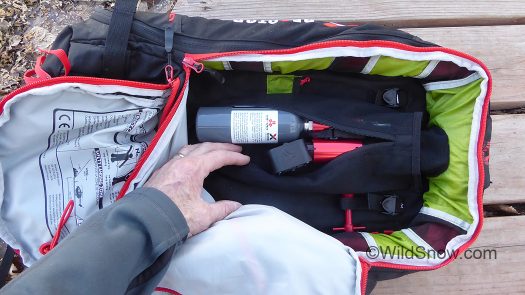
Guts and glory. New smaller cylinder is excellent, but as with many airbag packs the plumbing is smack dab in the middle of the cargo space.
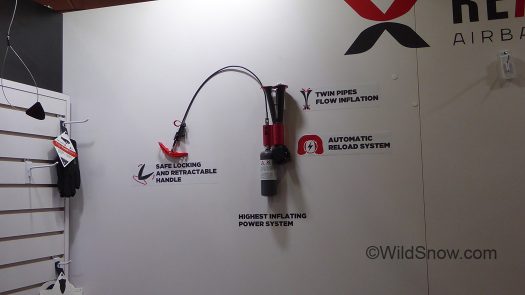
Another view of the guts. Astounding how far they have miniaturized this stuff. The threat of the electric fan packs no doubt gave all the gas pack makers a kick in the rear.
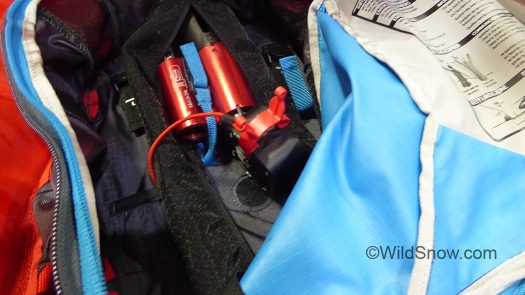
And, yet another view of the entrails. This time showing the deflator clip employed (it has to go on both sides of the valve as there are two ducts, one for each side of the balloon.
Overall, I like this pack. The build quality is excellent and much thought clearly went into the design. Due to how the trigger works and ski carry is configured, shopping for it at a retailer where you could evaluate in person would be wise.
The Reactor 18 is available now, but in limited quantities. Try the usual etail suspects.
WildSnow.com publisher emeritus and founder Lou (Louis Dawson) has a 50+ years career in climbing, backcountry skiing and ski mountaineering. He was the first person in history to ski down all 54 Colorado 14,000-foot peaks, has authored numerous books about about backcountry skiing, and has skied from the summit of Denali in Alaska, North America’s highest mountain.

